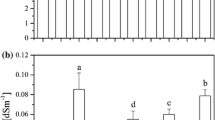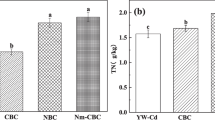Abstract
This study examined the effects of carbon nanotube and biochar on the bioavailability of Pb, Cu and Sb in the shooting range soils for developing low-cost remediation technology. Commercially available multi-walled carbon nanotube (MWCNT) and biochar pyrolyzed from soybean stover at 300 °C (BC) at 0.5, 1 and 2.5% (w w−1) were used to remediate the contaminated soil in an incubation experiment. Both DTPA (bioavailable) and TCLP (leaching) extraction procedures were used to compare the metal/loid availability and leaching by the amendments in soil. The addition of BC was more effective in immobilizing mobile Pb and Cu in the soil than that in MWCNT. The BC reduced the concentrations of Pb and Cu in the soil by 17.6 and 16.2%, respectively. However, both MWCNTs and BC increased Sb bioavailability by 1.4-fold and 1.6-fold, respectively, in DTPA extraction, compared to the control. The toxicity characteristic leaching procedure (TCLP) test showed that the leachability of Pb in the soil amended with 2.5% MWCNT was 1.3-fold higher than that the unamended soil, whereas the BC at 2.5% decreased the TCLP-extractable Pb by 19.2%. Precipitation and adsorption via electrostatic and π–π electron donor–acceptor interactions were postulated to be involved in the interactions of Pb and Cu with surfaces of the BC in the amended soils, whereas ion exchange mechanisms might be involved in the immobilization of Cu in the MWCNT-amended soils. The application of BC derived from soybean stover can be a low-cost technology for simultaneously immobilizing bioavailable Pb and Cu in the shooting range soils; however, neither of amendments was effective in Sb immobilization.





Similar content being viewed by others
Change history
04 January 2018
Unfortunately, in the original publication of the article, Prof. Yong Sik Ok’s affiliation was incorrectly published. The author’s affiliation is as follows.
References
Ahmad, M., Lee, S. S., Dou, X., Mohan, D., Sung, J.-K., Yang, J. E., et al. (2012). Effects of pyrolysis temperature on soybean stover-and peanut shell-derived biochar properties and TCE adsorption in water. Bioresource Technology, 118, 536–544.
Ahmad, M., Lee, S., Oh, S.-E., Mohan, D., Moon, D., Lee, Y., et al. (2013). Modeling adsorption kinetics of trichloroethylene onto biochars derived from soybean stover and peanut shell wastes. Environmental Science and Pollution Research, 20, 8364–8373.
Ahmad, M., Rajapaksha, A. U., Lim, J. E., Zhang, M., Bolan, N., Mohan, D., et al. (2014a). Biochar as a sorbent for contaminant management in soil and water: A review. Chemosphere, 99, 19–33.
Ahmad, M., Lee, S. S., Lim, J. E., Lee, S.-E., Cho, J. S., Moon, D. H., et al. (2014b). Speciation and phytoavailability of lead and antimony in a small arms range soil amended with mussel shell, cow bone and biochar: EXAFS spectroscopy and chemical extractions. Chemosphere, 95, 433–441.
Ahmad, M., Ok, Y. S., Rajapaksha, A. U., Lim, J. E., Kim, B.-Y., Ahn, J.-H., et al. (2016). Lead and copper immobilization in a shooting range soil using soybean stover-and pine needle-derived biochars: Chemical, microbial and spectroscopic assessments. Journal of Hazardous Materials, 301, 179–186.
Almaroai, Y. A., Vithanage, M., Rajapaksha, A. U., Lee, S. S., Dou, X., Lee, Y. H., et al. (2014). Natural and synthesised iron-rich amendments for As and Pb immobilisation in agricultural soil. Chemistry and Ecology, 30, 267–279.
Anderson, J. M., & Ingram, J. S. I. (1998). Trophical soil biology and fertility (2nd ed.). Wallingford, CT: CABI Publishing.
Antoniadis, V., & Alloway, B. (2002). The role of dissolved organic carbon in the mobility of Cd, Ni and Zn in sewage sludge-amended soils. Environmental Pollution, 117, 515–521.
Beesley, L., Moreno-Jiménez, E., & Gomez-Eyles, J. L. (2010). Effects of biochar and greenwaste compost amendments on mobility, bioavailability and toxicity of inorganic and organic contaminants in a multi-element polluted soil. Environmental Pollution, 158, 2282–2287.
Cao, X., Ma, L., Liang, Y., Gao, B., & Harris, W. (2011). Simultaneous immobilization of lead and atrazine in contaminated soils using dairy-manure biochar. Environmental Science and Technology, 45, 4884–4889.
Herath, I., Kumarathilaka, P., Navaratne, A., Rajakaruna, N., & Vithanage, M. (2015). Immobilization and phytotoxicity reduction of heavy metals in serpentine soil using biochar. Journal of Soils and Sediments, 15, 126–138.
Houben, D., Evrard, L., & Sonnet, P. (2013). Mobility, bioavailability and pH-dependent leaching of cadmium, zinc and lead in a contaminated soil amended with biochar. Chemosphere, 92, 1450–1457.
Inyang, M., Gao, B., Zimmerman, A., Zhang, M., & Chen, H. (2014). Synthesis, characterization, and dye sorption ability of carbon nanotube–biochar nanocomposites. Chemical Engineering Journal, 236, 39–46.
Jin, H., Capareda, S., Chang, Z., Gao, J., Xu, Y., & Zhang, J. (2014). Biochar pyrolytically produced from municipal solid wastes for aqueous As (V) removal: Adsorption property and its improvement with KOH activation. Bioresource Technology, 169, 622–629.
Liu, Z., Chen, L., Zhang, Z., Li, Y., Dong, Y., & Sun, Y. (2013). Synthesis of multi-walled carbon nanotube–hydroxyapatite composites and its application in the sorption of Co (II) from aqueous solutions. Journal of Molecular Liquids, 179, 46–53.
Luo, C., Liu, C., Wang, Y., Liu, X., Li, F., Zhang, G., et al. (2011). Heavy metal contamination in soils and vegetables near an e-waste processing site, south China. Journal of Hazardous Materials, 186, 481–490.
Mebius, L. J. (1960). A rapid method for the determination of organic carbon in soil. Analytica Chimica Acta, 22, 120–124.
Okkenhaug, G., Amstätter, K., Lassen Bue, H., Cornelissen, G., Breedveld, G. D., Henriksen, T., et al. (2013). Antimony (Sb) contaminated shooting range soil: Sb mobility and immobilization by soil amendments. Environmental Science and Technology, 47, 6431–6439.
Peijnenburg, W. J., Zablotskaja, M., & Vijver, M. G. (2007). Monitoring metals in terrestrial environments within a bioavailability framework and a focus on soil extraction. Ecotoxicology and Environmental Safety, 67, 163–179.
Pillay, K., Cukrowska, E. M., & Coville, N. J. (2009). Multi-walled carbon nanotubes as adsorbents for the removal of parts per billion levels of hexavalent chromium from aqueous solution. Journal of Hazardous Materials, 166, 1067–1075.
Rajapaksha, A. U., Vithanage, M., Oze, C., Bandara, W. M. A. T., & Weerasooriya, R. (2012). Nickel and manganese release in serpentine soil from the Ussangoda Ultramafic Complex, Sri Lanka. Geoderma, 189–190, 1–9.
Rajapaksha, A. U., Ahmad, M., Vithanage, M., Kim, K.-R., Chang, J. Y., Lee, S. S., et al. (2015). The role of biochar, natural iron oxides, and nanomaterials as soil amendments for immobilizing metals in shooting range soil. Environmental Geochemistry and Health, 37, 1–12.
Singh, R., Gautam, N., Mishra, A., & Gupta, R. (2011). Heavy metals and living systems: An overview. Indian Journal of Pharmacology, 43, 246.
Suthar, S., Singh, S., & Dhawan, S. (2008). Earthworms as bioindicator of metals (Zn, Fe, Mn, Cu, Pb and Cd) in soils: is metal bioaccumulation affected by their ecological category? Ecological Engineering, 32, 99–107.
Uchimiya, M., Bannon, D. I., & Wartelle, L. H. (2012). Retention of heavy metals by carboxyl functional groups of biochars in small arms range soil. Journal of Agricultural and Food Chemistry, 60, 1798–1809.
Vithanage, M., Rajapaksha, A. U., Ahmad, M., Uchimiya, M., Dou, X., Alessi, D. S., et al. (2015). Mechanisms of antimony adsorption onto soybean stover-derived biochar in aqueous solutions. Journal of Environmental Management, 151, 443–449.
Yang, W., Ding, P., Zhou, L., Yu, J., Chen, X., & Jiao, F. (2013). Preparation of diamine modified mesoporous silica on multi-walled carbon nanotubes for the adsorption of heavy metals in aqueous solution. Applied Surface Science, 282, 38–45.
Zheng, R.-L., Cai, C., Liang, J.-H., Huang, Q., Chen, Z., Huang, Y.-Z., et al. (2012). The effects of biochars from rice residue on the formation of iron plaque and the accumulation of Cd, Zn, Pb, As in rice (Oryza sativa L.) seedlings. Chemosphere, 89, 856–862.
Acknowledgements
This work was supported by the National Research Foundation of Korea (NRF) grant funded by the Korea government (MSIP) (NRF-2015R1A2A2A11001432, Contribution: 100%). The instrumental analyses were performed at the Central Laboratory of Kangwon National University. The elemental analyzer was performed at the National Center for Inter-University Research Facilities of Seoul National University.
Author information
Authors and Affiliations
Corresponding authors
Additional information
A correction to this article is available online at https://doi.org/10.1007/s10653-017-0046-z.
Rights and permissions
About this article
Cite this article
Vithanage, M., Herath, I., Almaroai, Y.A. et al. Effects of carbon nanotube and biochar on bioavailability of Pb, Cu and Sb in multi-metal contaminated soil. Environ Geochem Health 39, 1409–1420 (2017). https://doi.org/10.1007/s10653-017-9941-6
Received:
Accepted:
Published:
Issue Date:
DOI: https://doi.org/10.1007/s10653-017-9941-6




